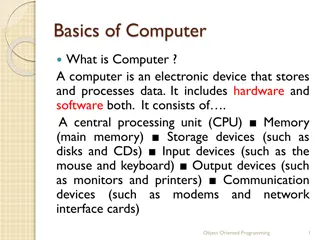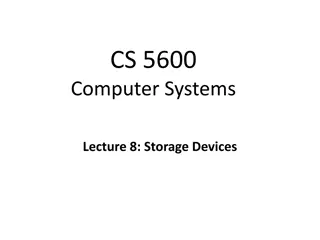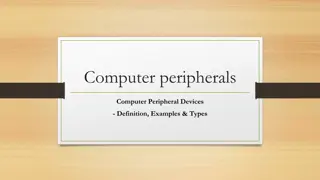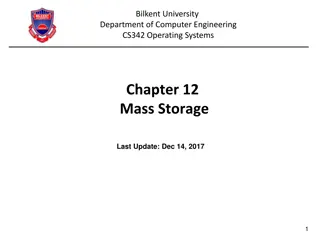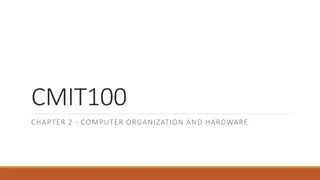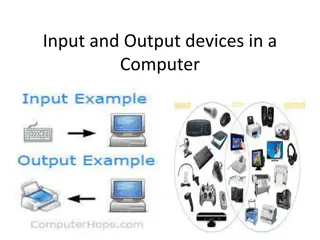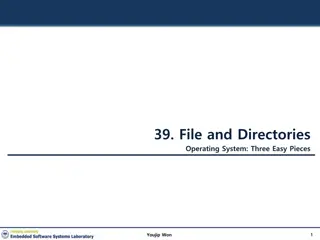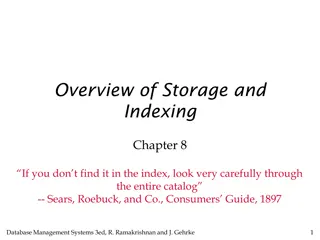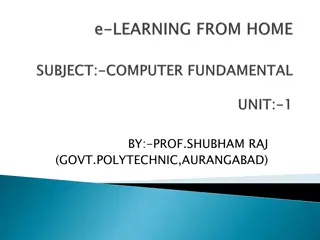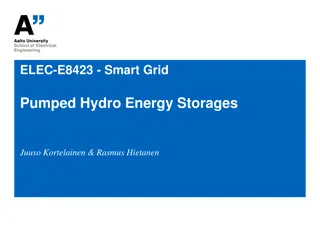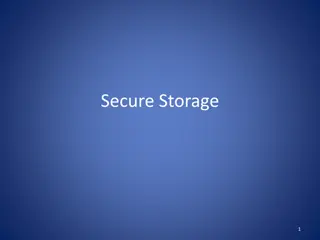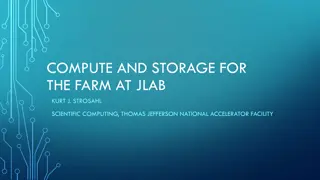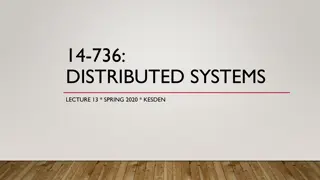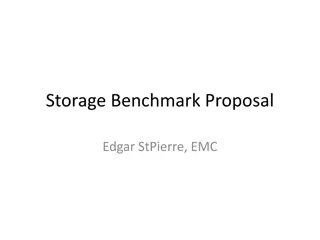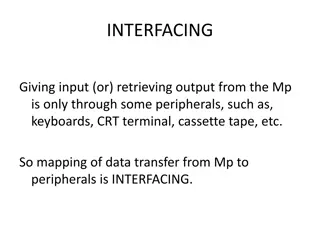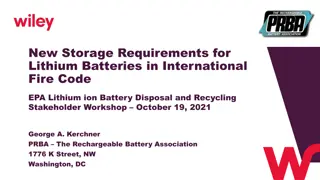Understanding File Systems and Storage Devices in Computer Systems
Learn about the abstraction on top of physical storage devices, including magnetic disks and flash memory, and how file systems provide useful abstractions to manage and store data effectively. Explore the performance characteristics, crash tolerance, and access control features of file systems, as well as the differences between magnetic disks and flash memory in terms of storage capacity, access speed, and reliability.
Download Presentation

Please find below an Image/Link to download the presentation.
The content on the website is provided AS IS for your information and personal use only. It may not be sold, licensed, or shared on other websites without obtaining consent from the author. Download presentation by click this link. If you encounter any issues during the download, it is possible that the publisher has removed the file from their server.
E N D
Presentation Transcript
Main Points File systems Useful abstractions on top of physical devices Storage hardware characteristics Disks and flash memory File system usage patterns
File Systems Abstraction on top of persistent storage Magnetic disk Flash memory (e.g., USB thumb drive) Devices provide Storage that (usually) survives across machine crashes Block level (random) access Large capacity at low cost Relatively slow performance Magnetic disk read takes 10-20M processor instructions
File System as Illusionist: Hide Limitations of Physical Storage Persistence of data stored in file system: Even if crash happens during an update Even if disk block becomes corrupted Even if flash memory wears out Naming: Named data instead of disk block numbers Directories instead of flat storage Byte addressable data even though devices are block- oriented Performance: Cached data Data placement and data structure organization Controlled access to shared data
File System Abstraction File system Persistent, named data Hierarchical organization (directories, subdirectories) Access control on data File: named collection of data Linear sequence of bytes (or a set of sequences) Read/write or memory mapped Crash and storage error tolerance Operating system crashes (and disk errors) leave file system in a valid state Performance Achieve close to the hardware limit in the average case
Storage Devices Magnetic disks Storage that rarely becomes corrupted Large capacity at low cost Block level random access Slow performance for random access Better performance for streaming access Flash memory Storage that rarely becomes corrupted Capacity at intermediate cost (50x disk) Block level random access Good performance for reads; worse for random writes
Disk Tracks ~ 1 micron wide Wavelength of light is ~ 0.5 micron Resolution of human eye: 50 microns 100K tracks on a typical 2.5 disk Separated by unused guard regions Reduces likelihood neighboring tracks are corrupted during writes (still a small non-zero chance) Track length varies across disk Outside: More sectors per track, higher bandwidth Disk is organized into regions of tracks with same # of sectors/track Only outer half of radius is used Most of the disk area in the outer regions of the disk
Sectors Sectors contain sophisticated error correcting codes Disk head magnet has a field wider than track Hide corruptions due to neighboring track writes Sector sparing Remap bad sectors transparently to spare sectors on the same surface Slip sparing Remap all sectors (when there is a bad sector) to preserve sequential behavior Track skewing Sector numbers offset from one track to the next, to allow for disk head movement for sequential ops
Disk Performance Disk Latency = Seek Time + Rotation Time + Transfer Time Seek Time: time to move disk arm over track (1-20ms) Fine-grained position adjustment necessary for head to settle Head switch time ~ track switch time (on modern disks) Rotation Time: time to wait for disk to rotate under disk head Disk rotation: 4 15ms (depending on price of disk) On average, only need to wait half a rotation Transfer Time: time to transfer data onto/off of disk Disk head transfer rate: 50-100MB/s (5-10 usec/sector) Host transfer rate dependent on I/O connector (USB, SATA, )
Question How long to complete 500 random disk reads, in FIFO order?
Question How long to complete 500 random disk reads, in FIFO order? Seek: average 10.5 msec Rotation: average 4.15 msec Transfer: 5-10 usec 500 * (10.5 + 4.15 + 0.01)/1000 = 7.3 seconds
Question How long to complete 500 sequential disk reads?
Question How long to complete 500 sequential disk reads? Seek Time: 10.5 ms (to reach first sector) Rotation Time: 4.15 ms (to reach first sector) Transfer Time: (outer track) 500 sectors * 512 bytes / 128MB/sec = 2ms Total: 10.5 + 4.15 + 2 = 16.7 ms Might need an extra head or track switch (+1ms) Track buffer may allow some sectors to be read off disk out of order (-2ms)
Question How large a transfer is needed to achieve 80% of the max disk transfer rate?
Question How large a transfer is needed to achieve 80% of the max disk transfer rate? Assume x rotations are needed, then solve for x: 0.8 (10.5 ms + (1ms + 8.5ms) x) = 8.5ms x Total: x = 9.1 rotations, 9.8MB
Disk Scheduling FIFO Schedule disk operations in order they arrive Downsides?
Disk Scheduling Shortest seek time first Not optimal! Suppose cluster of requests at far end of disk Downsides?
Disk Scheduling SCAN: move disk arm in one direction, until all requests satisfied, then reverse direction Also called elevator scheduling
Disk Scheduling CSCAN: move disk arm in one direction, until all requests satisfied, then start again from farthest request
Disk Scheduling R-CSCAN: CSCAN but take into account that short track switch is < rotational delay
Question How long to complete 500 random disk reads, in any order?
Question How long to complete 500 random disk reads, in any order? Disk seek: 1ms (most will be short) Rotation: 4.15ms Transfer: 5-10usec Total: 500 * (1 + 4.15 + 0.01) = 2.2 seconds Would be a bit shorter with R-CSCAN vs. 7.3 seconds if FIFO order
Question How long to read all of the bytes off of a disk?
Question How long to read all of the bytes off of a disk? Disk capacity: 320GB Disk bandwidth: 54-128MB/s Transfer time = Disk capacity / average disk bandwidth ~ 3500 seconds (1 hour)
Flash Memory Writes must be to clean cells; no update in place Large block erasure required before write Erasure block: 128 512 KB Erasure time: Several milliseconds Write/read page (2-4KB) 50-100 usec
Question Why are random writes so slow? Random write: 2000/sec Random read: 38500/sec
Flash Translation Layer Flash device firmware maps logical page # to a physical location Garbage collect erasure block by copying live pages to new location, then erase More efficient if blocks stored at same time are deleted at same time (e.g., keep blocks of a file together) Wear-levelling: only write each physical page a limited number of times Remap pages that no longer work (sector sparing) Transparent to the device user
File System Flash How does Flash device know which blocks are live? Live blocks must be remapped to a new location during erasure TRIM command File system tells device when blocks are no longer in use
File System Workload File sizes Are most files small or large? Which accounts for more total storage: small or large files?
File System Workload File sizes Are most files small or large? SMALL Which accounts for more total storage: small or large files? LARGE
File System Workload File access Are most accesses to small or large files? Which accounts for more total I/O bytes: small or large files?
File System Workload File access Are most accesses to small or large files? SMALL Which accounts for more total I/O bytes: small or large files? LARGE
File System Workload How are files used? Most files are read/written sequentially Some files are read/written randomly Ex: database files, swap files Some files have a pre-defined size at creation Some files start small and grow over time Ex: program stdout, system logs
File System Design For small files: Small blocks for storage efficiency Concurrent ops more efficient than sequential Files used together should be stored together For large files: Storage efficient (large blocks) Contiguous allocation for sequential access Efficient lookup for random access May not know at file creation Whether file will become small or large Whether file is persistent or temporary Whether file will be used sequentially or randomly
File System Abstraction Directory Group of named files or subdirectories Mapping from file name to file metadata location Path String that uniquely identifies file or directory Ex: /cse/www/education/courses/cse451/12au Links Hard link: link from name to metadata location Soft link: link from name to alternate name Mount Mapping from name in one file system to root of another
UNIX File System API create, link, unlink, createdir, rmdir Create file, link to file, remove link Create directory, remove directory open, close, read, write, seek Open/close a file for reading/writing Seek resets current position fsync File modifications can be cached fsync forces modifications to disk (like a memory barrier)
File System Interface UNIX file open is a Swiss Army knife: Open the file, return file descriptor Options: if file doesn t exist, return an error If file doesn t exist, create file and open it If file does exist, return an error If file does exist, open file If file exists but isn t empty, nix it then open If file exists but isn t empty, return an error
Interface Design Question Why not separate syscalls for open/create/exists? Would be more modular! if (!exists(name)) create(name); // can create fail? fd = open(name); // does the file exist?




